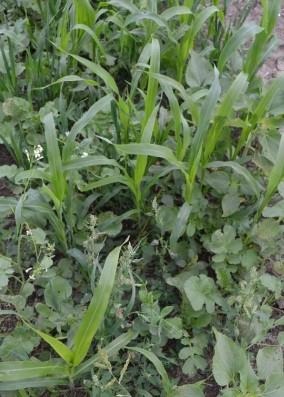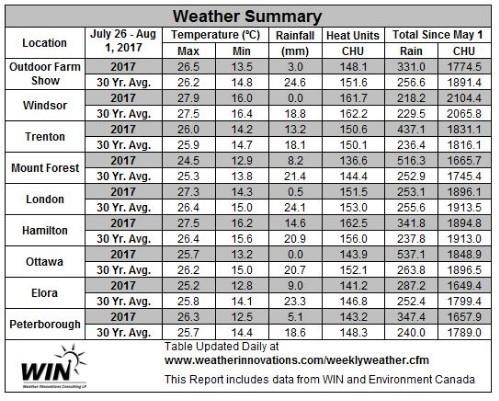Cover Crops
The underseeded red clover is looking pretty good where the winter wheat has been harvested. As is often the case some fields have variable stands and others have poor or non-existent stands. If the red clover stand is poor and it is insured nothing can be done until it is released by Agricorp. If it is not insured then now is a good time to improve it. If there are some thin spots in it, those areas can be patched with another legume. Crimson clover is a good option and red clover can also be seeded at this time. Other clovers or peas are good options as well. If all that is desired is inexpensive quick cover then oats are a good option. If very little red clover exists there a wide range of options to choose from.
If no cover crop was planned after winter wheat it is not too late to consider planting one. Cover crops can help improve soil structure, protect the soil from erosion, feed soil life, suppress weeds, cycle nutrients, and provide feed for livestock and much more. Research at University of Guelph, Ridgetown Campus has shown that planting a cover crop provides a benefit, even if the growth is limited. So consider the options and find a way to reap the benefits of cover crops.
Select a cover crop to meet the goals for the field. Also consider how it will fit into your cropping and tillage system and how much time there will be for the cover crop to grow. Some options that will achieve good ground cover at a reasonable cost are: oats or barley, oats and radish, and oats and peas. Combinations of a grass or cereal, legume and brassica also work well and can provide a diversity of growth and root types.
Before planting a cover crop it is important to think about what management it may require. Many cover crops are killed by frost and don’t require a herbicide treatment. Others will survive the winter and will need to be killed in the fall or spring. Some will go to seed, so they will need to be mowed or managed before then. Tillage, using a roller crimper or grazing are other methods that can be used to manage or terminate the cover crop.
Plant the cover crop as soon as possible to achieve the most growth. Drilling the cover crop in is the most effective but other methods can work. If planting is delayed until after Labour Day it is best to plant a winter cereal as a frost will likely kill off other cover crops before they can achieve much growth.
Some areas have had too much rain and parts of fields or whole fields have no crop in them. For some options for those fields visit the Field Crop News site.
New this year Agricorp is offering production insurance for cover crops. The coverage is called New Forage Seeding and is available for a wide range of cover crops. The acreage to be covered must be reported by September 1st. Visit the Agricorp website for more information.
The OMAFRA website http://www.omafra.gov.on.ca (in the soil management section) provides comprehensive information on cover crop species selection and management. OMAFRA also has a poster and series of cards that provide information on cover crop options and seeding rates. The Field Crop News website http://fieldcropnews.com/ has several articles on cover crops as well.

Figure 1. A cover crop mixture can provide crop diversity and a variety of root types.
Soybean Disease and Insects
The hot dry conditions have been good for a number of soybean diseases and pests. One of these is the two- spotted spider mite which feed on individual plant cells on the underside of leaves. The feeding can cause severe stippling/speckling, yellowing, curling and bronzing of the leaves. Upon close examination, fine webbing on lower surfaces of the leaf can be seen. Spider mites usually start at the edges of the field, but windy days can carry them in from other sites, with pockets starting up deeper into the field. From the road, these pockets may be confused for drought stress. Scout margins of the field for spider mite injury and if areas continue to expand and an average of 4 mites per leaf is found an insecticide spot or field spray may be necessary. Do not use a pyrethroid insecticide for the control of spider mites, as it will kill the beneficial mites and cause the spider mite populations to increase.
Soybean cyst nematode and sudden death syndrome are two diseases which have been favoured by the dry conditions. Both of these can also look like other problems including manganese. Dig plants with a shovel and gently remove soil and examine roots for the presence of the small white to yellow coloured cysts. Sudden death syndrome (SDS) symptoms appear on the leaves as yellow and brown areas between the veins while the veins remain green which can be confused with manganese deficiency (Figure 2.). Leaves will drop but the petioles will remain in those plants infected with SDS. To confirm SDS, cut the root and stems and look for root rot and brown discoloured streaks in the stem. The center pith will remain white.

Figure 2. Sudden Death Syndrome.
Table 1. July 26 – August 1, 2017 Weather data

Source: FieldCropNews